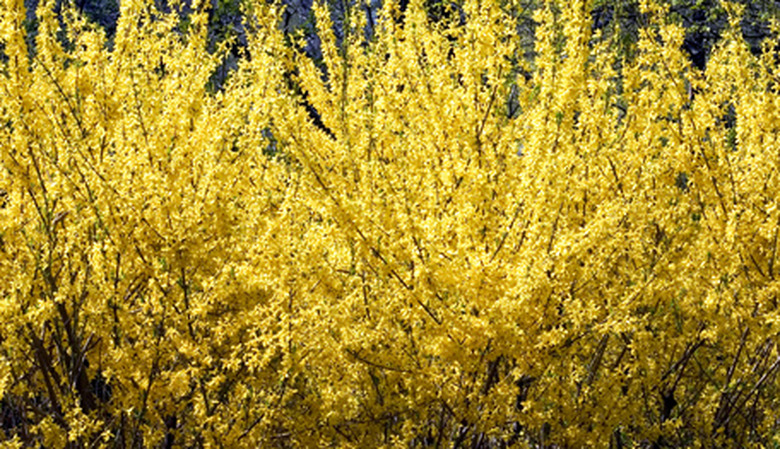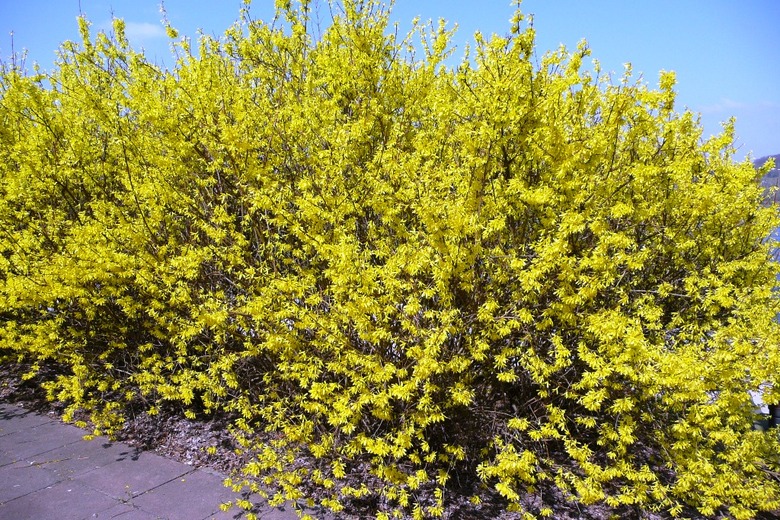How To Grow Forsythia For Privacy Hedges
In late winter and early spring, forsythia is a welcome sight; its deep yellow flowers are sometimes the only spot of color in the landscape. However, if you want to use forsythia (Forsythia spp.) as a privacy hedge, be aware that this bush is a deciduous shrub, so it loses its foliage in fall and winter and provides little privacy during that time.
About Forsythia Bushes
The standard forsythia is the "border forsythia," or Forsythia x intermedia, which grows in USDA hardiness zones 5 to 8. This variety is a cross between two species, weeping forsythia (Forsythia suspensa, zones 5 to 8) and greenstem forsythia (Forsythia viridissima, zones 6 to 8), and comprises multiple cultivars of varying sizes and characteristics.
You can also find many cultivars other than border forsythias, but if you want to create a privacy hedge, you'll need to select a full-size variety rather than a dwarf variety, so pay attention to the plant tags.
Forsythias are fast-growing flowering shrubs that do best in full sun and flower in late winter or early spring. If you are growing these plants primarily for their yellow blooms, you're in for a short, two-week wonder because these blooms fade fast.
When they fade in spring, that's the time to prune, because forsythia blooms on old wood. If you wait too long, you may prune off flower buds that will become your flowers next year.
Creating a Forsythia Hedge
You had better have a lot of room, because a single forsythia can spread quickly, sending out large canes and suckering heavily.
Plant the Forsythias
Choose a well-draining location in full sun. The soil doesn't need special amendments, as this plant grows well in even poor soil. Space forsythias about 3 to 4 feet apart to create a hedge. Water new plants well during their first season.
Cultivate the Hedge
Forsythias quickly put on new growth. Wait until the first season's flowering is finished to begin shaping your bushes.
Tip
Forsythia branches have a natural arching growth habit in which the canes shoot straight upward and bend from the weight of their flowers. Don't try to fight this by using shears and pruning forsythia plants into a tight shape like you might boxwood, or you will ruin their natural beauty and create conditions conducive to "water sprouts," which are multiple, small, unattractive sprays of stems.
Avoid attempting to create a boxy, square shape. Instead, allow the forsythias to grow into their natural arching habit while training any branches that reach toward other plants in the hedge and removing those that spread out of bounds into your yard. Here are the basics:
1. Remove 1/4 of the oldest stems because older wood thickens and can decrease space and circulation within the plant. If any stems are touching other stems, remove those. Using a lopper or a hand saw, cut some as close to the ground as possible while cutting others at varying heights to encourage a natural form. 2. Remove dead or diseased branches or any that are growing inward. Always cut the branch all the way back to a main stem; otherwise, you will create conditions that produce water sprouts. 3. Cut off any canes that are reaching outside the area where you are developing your hedge. For instance, retain canes that close the gap between your forsythia plants while removing those that arch too far forward or backward outside the "hedge." Be sure to remove them all the way back to the ground.
Basically, the only difference between pruning a specimen forsythia and one that is trained to be part of a hedge is removing canes that are growing out of the area where you want your hedge.
Seasonal Maintenance
Forsythia shrubs need no fertilization, but mulch them annually with composted manure for optimum growth. They are also susceptible to few diseases or pests, although they may attract spider mites, aphids or northern root-knot nematodes.

